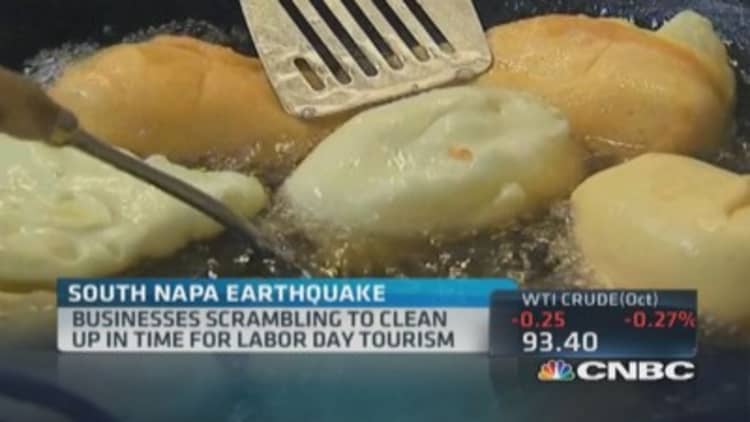As winemakers around Napa Valley clean up following the weekend's 6.0-magnitude earthquake, many of them will have to pay for the economic damage caused by the quake out of their own pockets.
Winemaking is the area's top industry, followed by tourism. Both were affected by the quake, and experts say it's still too early to tell how far the economic aftershocks will ripple.
Risk modeling company Eqecat estimated that insured losses could be as high as $1 billion, with anywhere from half to three-quarters of that from the business sector. "If the loss exceeds $1 billion it will be from uncertainty in commercial losses. It is anticipated that losses to the wine industry could increase this estimate," Eqecat said.
Read More90 percent of Californians lack earthquake insurance
Since growers had already begun harvesting and processing the grapes, the quake did more damage than if the grapes had still been hanging on the vine when it struck, although wineries would have suffered even greater losses if the harvest season had been further along.
"In another month, we would've had double the amount in barrels," said Liz Thach, a professor at Sonoma State University's Wine Business Institute.
"Some NVV [Napa Valley Vintners] member wineries did sustain damage to their barrel storage areas, wine inventory and production equipment over the weekend," the 500-member trade association said in a statement.
More from NBC News:
Napa ready for tourists despite quake cleanup
California governor signs bill requiring smartphone 'kill switch'
Hotels say 'I do' to proposal packages
Some experts think the final tally will be even higher. Taking into account residential losses along with wineries' loss of product, damaged facilities and canceled bookings from tourists, the quake could inflict losses as high as $4 billion, according to Kinetic Analysis Corporation data. Insurance is likely to cover only about $1.5 billion of that, "due to the (earthquake) insurance penetration figures in that area ... and the heavy impact of this event on contents (and) inventory," Kinetic CEO Steven Stichter said via email.
It's unknown what percentage of Napa's more than 500 wineries carry earthquake insurance, but it's likely a small number.
"We do know that fewer than 6 percent of homeowners in the Napa area have earthquake coverage and that take-ups rates across the state for this type of insurance have been declining for nearly 20 years," Insurance Information Institute president and economist Bob Hartwig said via email.
Read MorePinot in aluminum cans? Believe it
Forgoing earthquake coverage is usually a decision driven by finances, especially for smaller wineries or those just starting out. "It's actually rather common because it's incredibly expensive," Thach said. With years or even decades between major quakes in the Napa region, it might not make sense for a winery to elect for insurance, she said.
Not only can the premium cost as much as a winery's combined costs for property, liability and other standard business insurance, but deductibles are high and limits on damages are low, said Paul Fuller, a senior vice president at commercial insurance provider Alteris Inc.
For instance, he said, a winery producing 25,000 cases a year might have an insurance package costing between $50,000 and $75,000 annually. A separate policy for earthquake coverage could easily cost the same amount or more.

The other two factors that discourage wineries from buying earthquake coverage are the deductible, which might be 15 percent of the total insured value, and the limit, which Fuller said wineries often cap at 25 percent of the total insured value.
"We never anticipated the degree of damage in Napa for an earthquake," Fuller said. "The cost-benefit before Sunday just wasn't there, in many instances."
—NBC News' Martha C. White

